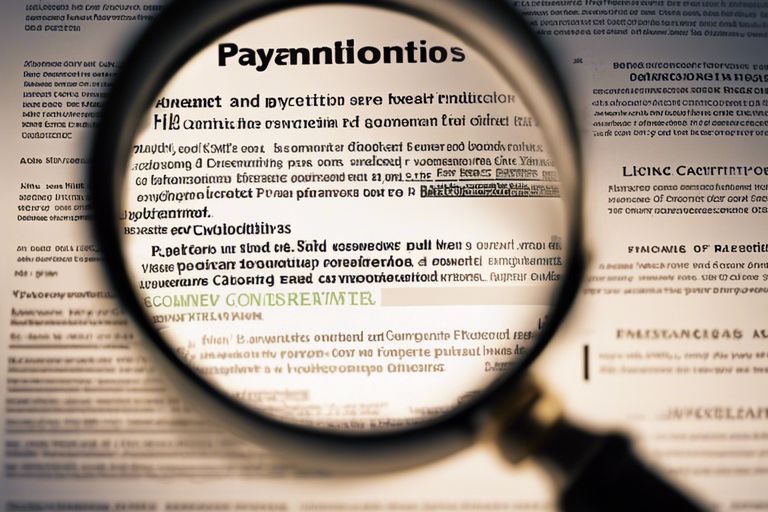Decoding the Fine Print of Payment Terms

Just receiving your invoice isn’t the end of the payment process. Understanding the fine print of payment terms can make a significant difference in your financial obligations and business relationships. While it may seem like tedious work, taking the time to decode the terms can help you avoid costly late fees, maintain positive cash flow, and build a reputation for reliability with your vendors.
The Basics of Payment Terms
Before delving into the intricate details of payment terms, it is imperative to understand the fundamental concepts that form the basis of these terms. This chapter will decode the fine print of payment terms, starting with defining its components and exploring common types that are prevalent in business transactions.
Definition and Components
Components: Payment terms refer to the agreed-upon conditions between a buyer and a seller regarding when and how payment will be made for goods or services. These terms play a crucial role in managing cash flow and ensuring smooth financial transactions in business dealings.
Key components often found in payment terms include the payment due date, any applicable discounts for early payments, late fees for overdue payments, and methods of payment accepted by the seller.
Common Types of Payment Terms
- Net 30: Payment is due 30 days from the invoice date.
- 2/10 Net 30: A 2% discount is provided if payment is made within 10 days; otherwise, full payment is due in 30 days.
- Due on Receipt: Payment is required immediately upon receipt of goods or services.
- Payment in Advance: Payment must be made before goods are shipped or services are provided.
- Recurring Payments: Payments made on a regular schedule, such as monthly or quarterly.
Understanding these common types of payment terms is imperative for both buyers and sellers to ensure clarity and avoid misunderstandings in financial transactions. Any oversight in comprehending the payment terms can lead to payment delays or disputes that may impact the business relationship.
| Payment Term | Description |
|---|---|
| Net 30 | Payment due 30 days from invoice date |
| 2/10 Net 30 | 2% discount if paid within 10 days, full payment due in 30 days |
| Due on Receipt | Payment required immediately upon goods or service receipt |
| Payment in Advance | Payment before goods shipped or services provided |
| Recurring Payments | Regular payments on a schedule (e.g., monthly, quarterly) |
Payment Terms and the Cash Flow
The Influence on Cash Flow Management
To understand the impact of payment terms on cash flow, it is crucial to consider the timing of when payments are received and when expenses are due. Longer payment terms can lead to delayed cash inflows, affecting a company’s ability to meet immediate financial obligations. On the other hand, shorter payment terms can improve cash flow but may strain relationships with customers who require more time to pay.
Strategies for Optimizing Cash Flow through Payment Terms
An effective way to optimize cash flow through payment terms is to negotiate terms that strike a balance between the needs of your business and those of your customers. Offering discounts for early payment can incentivize customers to pay sooner, improving cash flow. Conversely, charging interest on late payments can encourage timely payments and mitigate the impact of delayed cash inflows.
Terms as these can be a double-edged sword, potentially jeopardizing relationships with customers if not managed properly. It is crucial to establish clear communication and set expectations to ensure that both parties benefit from the arrangement.
Negotiating Payment Terms
Key Considerations When Negotiating
Unlike other aspects of a business agreement, payment terms can significantly impact cash flow and profitability. It is crucial to carefully consider and negotiate these terms to ensure that they align with your company’s financial goals and capabilities.
Any negotiation involving payment terms should start by clearly outlining your needs and objectives. Be prepared to discuss factors such as payment deadlines, early payment discounts, and late payment penalties. Understanding your leverage in the negotiation process will help you secure favorable terms that benefit your business.
Negotiating with Suppliers and Clients
The negotiation process with suppliers and clients is a delicate balance between maintaining good relationships and securing the best payment terms for your business. It is important to communicate openly and transparently about your financial expectations and limitations.
Legal Implications of Payment Terms
Contractual Obligations and Rights
Your contractual obligations and rights regarding payment terms are crucial aspects of any business transaction. When you agree to specific payment terms with a vendor or client, you are entering into a legally binding agreement that outlines the expectations and responsibilities of both parties. It is vital to clearly understand these obligations to ensure compliance and avoid potential disputes or legal consequences.
The Consequences of Violating Payment Terms
Any deviation from the agreed-upon payment terms can have serious consequences for your business. Failure to adhere to payment terms may result in late fees, interest charges, damage to your credit rating, or even legal action by the other party. It is crucial to honor your payment obligations to maintain a good business reputation and avoid potential financial losses.
Implications: Understanding the legal implications of payment terms is crucial for safeguarding your business interests. Failure to comply with payment terms can lead to financial penalties, damaged relationships with business partners, and even legal action. It is imperative to prioritize timely payments and uphold your end of the contractual agreement to ensure smooth business operations and maintain trust with your business partners.
Payment Terms: Discounts and Penalties
Early Payment Discounts: Benefits and Drawbacks
Many businesses offer early payment discounts as an incentive for prompt settlement of invoices. This can result in significant cost savings for the buyer, providing a clear advantage. By taking advantage of these discounts, businesses can improve their cash flow and overall financial health. However, it’s imperative to weigh the benefits against any potential drawbacks.
Late Payment Fees and Interest Charges
With late payment fees and interest charges, businesses may face financial consequences for delayed payments. These penalties are designed to incentivize timely payments and compensate for the cost and inconvenience caused by late settlements. To avoid these charges, businesses should prioritize meeting payment deadlines and closely monitor their cash flow to ensure timely payments.
Drawbacks: While late payment fees and interest charges serve as effective deterrents against delayed payments, they can quickly escalate and become a significant financial burden for businesses. It is crucial for businesses to understand the terms and conditions regarding these penalties to avoid any unexpected costs.
Managing Payment Terms in Different Markets and Industries
The Role of Local Laws and Industry Standards
Standards in payment terms management can vary significantly across different markets and industries. Understanding the local laws and industry standards is crucial for businesses to navigate payment terms effectively. For example, certain industries may have specific payment terms that are standard practice, such as Net 30 for service-based businesses, while others may require immediate payment upon receipt of goods.
Moreover, local laws can dictate the maximum credit terms allowed, late payment penalties, and other aspects of payment terms. Ignoring these regulations can lead to legal issues and financial penalties, making it vital for businesses to stay compliant with both industry standards and local laws.
Adapting Payment Terms for International Transactions
For transactions that cross international borders, businesses must adapt their payment terms to account for currency exchange rates, international banking fees, and differing payment cultures. Offering flexible payment options, such as accepting multiple currencies or setting up international wire transfers, can help facilitate smoother transactions and build trust with overseas clients.
Technology and Tools for Managing Payment Terms
For businesses looking to streamline their payment processes and ensure timely payments, leveraging technology and tools can make a significant difference. From innovations in payment processing to software solutions for tracking and enforcing payment terms, there are various options available to help businesses manage their payment terms effectively.
Innovations in Payment Processing
Payment technologies have evolved significantly in recent years, offering businesses more efficient and secure ways to collect payments. From mobile payment solutions to integrated payment gateways, there are numerous options for businesses to choose from. These technologies not only streamline the payment process but also help in reducing late payments and improving cash flow management.
Software Solutions for Tracking and Enforcing Payment Terms
Terms management software can be incredibly helpful for businesses in tracking payment due dates, automating payment reminders, and enforcing late fees or penalties when necessary. These solutions provide a centralized platform for businesses to monitor their payment terms and take action proactively to address any issues that may arise.
One popular software solution in this category is accounting software that offers invoicing capabilities and payment tracking features. This software allows businesses to create and send invoices, track payment statuses, and set up automated reminders for overdue payments, helping them stay on top of their payment terms effectively.
Key Takeaways
Software solutions play a crucial role in helping businesses manage their payment terms efficiently. By leveraging technology and tools such as payment processing innovations and software solutions for tracking and enforcing payment terms, businesses can streamline their payment processes, reduce late payments, and improve cash flow management.
Solutions like integrated payment gateways and accounting software can offer businesses the necessary tools to monitor payment due dates, automate reminders, and enforce payment terms, ultimately leading to better financial health and stability for the business.
The Future of Payment Terms Management
Management of payment terms is expected to see further advancements in the future, with the development of more sophisticated software solutions and technologies. These advancements may include enhanced automation capabilities, machine learning algorithms for predicting payment behavior, and integration with other business systems for seamless payment processes.
As businesses continue to prioritize efficient payment management and cash flow optimization, the future of payment terms management is likely to focus on providing businesses with more insights, control, and flexibility in managing their payment terms effectively. By staying updated on the latest technology trends and adopting innovative tools, businesses can position themselves for success in managing their payment terms in the years to come.
FAQs
What are payment terms in business transactions?
Payment terms are conditions agreed upon between a buyer and seller regarding when and how payments for goods or services will be made. They include details like due dates, discounts for early payments, and penalties for late payments.
Why are payment terms important for businesses?
Clear payment terms help manage cash flow, reduce late payments, and maintain positive relationships with vendors and clients. Understanding these terms ensures financial stability and operational efficiency.
How do payment terms impact cash flow?
Longer payment terms delay cash inflows, affecting immediate financial obligations. Shorter terms improve cash flow but may strain customer relationships. Negotiating optimal terms is crucial for balancing these factors.
What are common types of payment terms used in business?
Common terms include Net 30 (payment due in 30 days), 2/10 Net 30 (2% discount if paid within 10 days), Due on Receipt (payment upon goods receipt), Payment in Advance, and Recurring Payments.
How should businesses negotiate payment terms effectively?
Effective negotiation involves understanding business needs, discussing deadlines, discounts, and penalties. It ensures terms align with financial goals while maintaining positive vendor and client relationships.
Recommended Posts

The Path to Payment Efficiency in iGaming
July 5, 2024

Novibet & OKTO: iGaming Payments with NoviCASH
July 4, 2024

iGaming Licenses and Global Expansion
July 4, 2024




